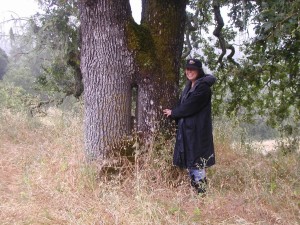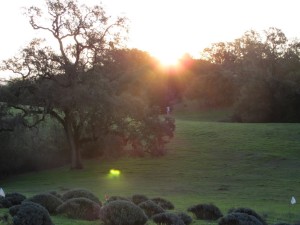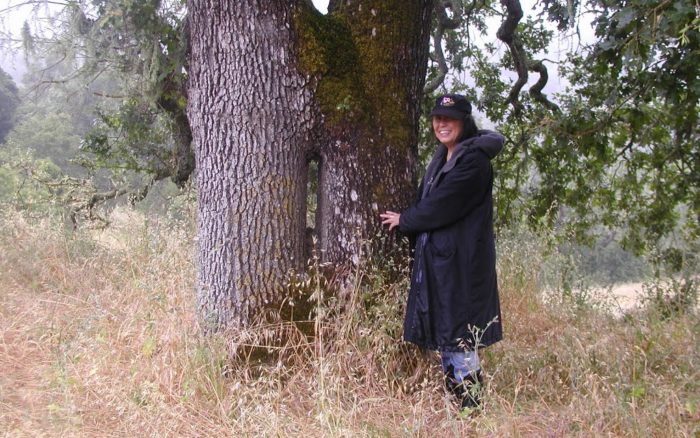 |
| Tree Person and grafted valley oaks. |
Stewardship and the Western European Way
How we western Europeans acquired our land was never discussed. History began, it seemed, with immigration, land grants, homesteading, staking claim. Anything before that was pre-history. The early cowboys settled the “wild west,” bravely fighting off hostile Indians who had lived there for thousands of years. This was only a hundred or so years ago, and shockingly, we are strangely ignorant about the impact of this aggression on all of us.
Our attitude, though, remains. The “God-given” right to “dominion over,” rationalized by mistranslations of the Old Testament, is reflected in how we relate to the non-human and the natural world, in our staunch claim to property rights, even in our granting rights to corporations to override the rights of the natural world in service of profitability.
Although there is evidence of this area being populated for at least 10,000 years, and some say as long as 60,000, most of the knowledge of how to live in balance with the natural world has been lost. First Peoples were killed by early settlers or by the diseases they brought along with invasive plants, animals, economies, and religions. It was illegal to practice their ceremonies into the 1990’s, ceremonies intimately related to nature and balance.
It gives one pause. My eyes rest on the stretch of meadow south of our kitchen, the one the bobcat and coyote regularly hunt and deer pass through. Hawk dip after their prey of gophers, and last year a pileated woodpecker built her nest in a dead tree on its edge. During the time that Goethe was writing his poetry and theories of metamorphosis, the meadow was sacred to the Mishewal Wappo (as all land is sacred, Charlie would say), but we no longer know what they did here. There is a knoll to the north on which old valley oaks are grafted together in ways that some say was done on the sites young couples spent their first night. The land is charged and stretches one’s heart to the fartherest corners of the universe; that remains. But the old stories and oral histories are gone, the ones passed from generation to generation— until General Vallejo received his land grant from the King of Spain, and history began.
But the stain is here. You can feel it. As an analyst I often have to encourage a patient to remember painful early experience and patterns which have formed neuro-pathways into the present. There is little hope of new choices, new ways, until we heal traumas evidenced in blocks and old ways carried forward. Trauma ignored seeks to replicate those circumstances in which it was first inflicted, an unconscious drive for healing and wholeness, perhaps. Yet sadly, most often such repetition only re-traumatizes.
This also happens in our relationship with the land. Our “dominion over” attitudes are moving us toward a sterile world. In the Napa Valley the battle continues: property rights advocates and vintners versus environmentalists. Meanwhile “conservation” is often equated with neglect, leaving an area alone to the forces of nature after a hundred years of non-tending, resulting, in the very least, in brush build up and the real danger of large and destructive fires.
It is in this context that, in the following weeks, I will post the video of a talk given by Charlie Toledo at Harms Vineyards and Lavender Fields Open House in June 2011. I was moved by a statement of the Suscol Intertribal Council that a focus is “to bring healing between the existing population and people who historically inhabited Napa Valley and nearby counties.” I suspect this is also key to healing our “dominion over” exploitive practices with the earth.
Charlie said, “Jim Big Bear King used to say, ‘Where’s my church? The sky is the roof. The Earth is the floor. The fire is the heart. Without these things, I cannot pray. Where’s my church?’” She continued, “The fire is like a telephone line to the universe. So the fire needs to touch the Earth and be open to the sky.”
May we let our hearts be this fire and, through this love, may we find our way into balance again with the spirits of those who came before, with each other, and with the earth.
 |
| Sacred meadow at sunrise. |
